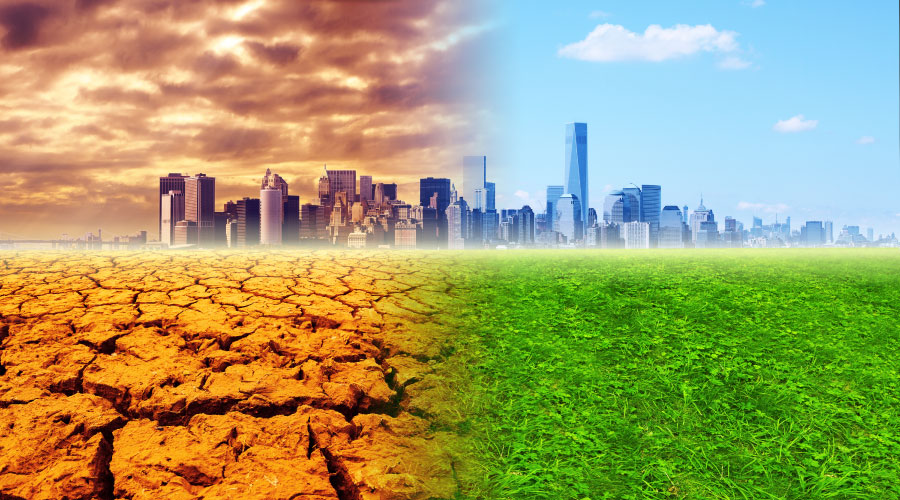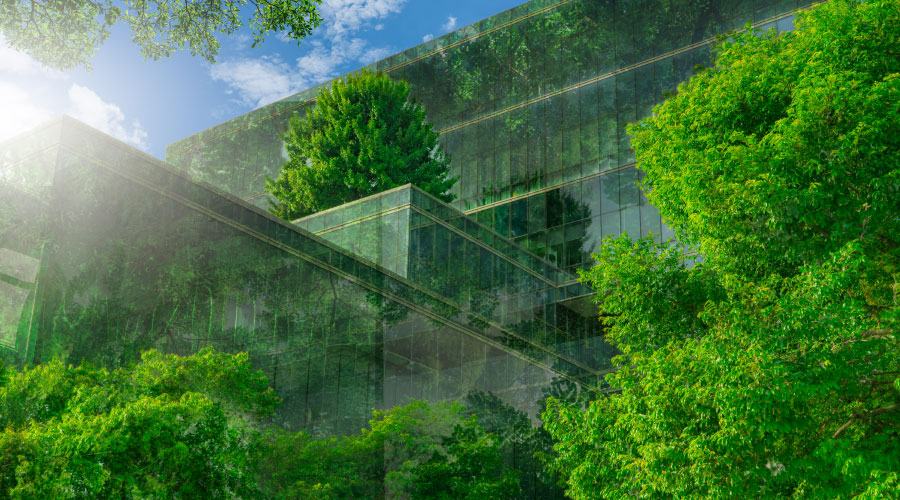Creating Green Space for Tenants
LEED for Commercial Interiors shows tenants how to improve the spaces they lease — and the base building as well
By Lacey Muszynski, Assistant Editor
As the popularity of green building skyrocketed after the launch of the LEED rating systems for New Construction (LEED-NC) and Existing Buildings (LEED-EB), organizations that leased space were feeling left out of the loop. Both LEED-NC and LEED-EB focused on the construction and operation of whole buildings. What were organizations that were committed to sustainable design, but that weren’t constructing new buildings, supposed to do?
These environmentally minded organizations and interior designers were clamoring for a new LEED rating system designed specifically for interiors. In response to this market demand, USGBC created LEED for Commercial Interiors (LEED-CI) in the fall of 2004, the first green rating system designed for tenants.
The principle focus of LEED-CI is the human aspect of green building, says Linda Sorrento, director of education and research partnership at USGBC. This means that while environmental responsibility is still a goal, the purpose of LEED-CI is to ensure the well-being of those who will be occupying the space.
“It’s the job of facility executives and interior designers to protect the human health, safety and welfare of people,” says Sorrento. “The LEED-CI rating system is perfect for doing that in leased space.”
LEED-CI has also had an unforeseen effect on the commercial real estate market. As more and more tenant spaces get LEED-CI certification, developers’ ears are perking up to the sound of green — design, that is.
Popularity Contest
When LEED-CI was first launched, USGBC geared it mainly towards offices. Now, almost three years later, it has spread to other building types and has become the industry benchmark for tenant improvement, says Garrick Maine, project architect and designer with Flad Architects. In fact, LEED-CI has more certified projects than LEED-EB. According to USGBC’s Web site, the total number of LEED-CI certified projects is 157, while LEED-EB certifications number 57.
One reason for LEED-CI’s popularity may be the benefits gained by tenants. Of these benefits, economic savings are high on the list. “In the long run, if you install high performance systems, eventually you save money,” says Mary Bolger, interior designer with Flad Architects.
Tenants that use LEED-CI to certify space also find it important to portray an image of environmental stewardship. Some organizations feel this can attract and retain employees as well as customers or clients. “A green certification enhances the environment tenants provide their employees, their visitors and their guests,” says Rico Cedro, director of sustainable design at Krueck and Sexton Architects. “Not only does sustainability affect traditional operating costs, it also affects other costs, such as absenteeism, sick days and productivity.”
For example, one large outdoor-product retailer found that its first LEED-CI certified store was experiencing higher sales and lower operating costs and that consumers were having a better experience, says Sorrento. That retail chain plans to have all locations LEED-CI certified, reflecting a trend that Sorrento and other experts are seeing: retailers going green. In response, USGBC is launching a pilot program for certified retail spaces.
In some organizations, LEED-CI allows the company to portray an image of consistency in its environmental ideals, says Cedro. Organizations with multiple facilities will often have leased-space locations. LEED-CI certification at those locations shows the public that the organization practices what it preaches. “Leased space is usually what the public sees most,” says Cedro. “Certifying leased space as well as owned space gives greater weight, consistency and validity to the company’s sustainability message through its real estate holdings.”
As the green building sector continues to expand, experts say it’s important for organizations that are on the fence about getting a LEED-CI certification to examine their role and responsibility to society. “If you want to be a successful organization in the 21st century,” says Cedro, “you better be thinking holistically about your space.”
Realm of the Tenant
LEED-CI takes on a format familiar to those already versed in other LEED rating systems. LEED-CI is divided into six categories: sustainable sites, water efficiency, energy and atmosphere, materials and resources, indoor environmental quality, and innovation and design process. Each category is broken down into individual credits for which points are awarded. The total number of points achieved throughout all categories determines the final certification level. A maximum of 57 points is possible. Levels range from Certified (21-26 points) to Platinum (42-57 points), the highest level awarded in LEED certifications.
Some categories have prerequisite credits, or credits which are mandatory for any certification level. There are a total of six prerequisites:
- Use of CFC alternatives in HVAC equipment
- Commissioning of energy-related systems
- Minimum energy performance
- Storage and collection of recyclables
- Minimum IAQ performance
- Environmental tobacco smoke control.
These prerequisites don’t usually deter tenants from pursuing or obtaining LEED-CI certification, says Cedro. Prerequisites on CFCs and minimum IAQ performance are usually an issue only in older facilities or industrial buildings converted into offices, he says. Some of the prerequisites — such as tobacco smoke control, commissioning and recycling — are already in place at many organizations.
When USGBC was developing LEED-CI, it recognized that most tenants cannot control a lot of the features of leased space.
“What tenants can and can’t control really depends on the scope of the project,” says Elaine Aye, principal, Green Building Services, a green building consulting firm. “In some cases, where a tenant is leasing an entire building, for example, they may be able to control the mechanical systems. It’s much more likely that a tenant leasing a couple floors in a multitenant office building will be at the mercy of whatever has been installed.”
Nevertheless, LEED-CI recognizes that tenants can influence the base building in which they are leasing space and seeks to maximize the influence a tenant may have on the building owner, says Sorrento. The LEED-CI committee intended to encourage tenants to go beyond what they can do in their space, she says.
The idea is to motivate a tenant to seek a more environmentally responsible building. Credits such as stormwater management, light pollution control and water efficiency may all be gained with a little research into prospective buildings. “Tenants can’t control those building aspects, but they can control which buildings they choose to be tenants in,” says Maine.
The best and most obvious location choice would be inside a LEED-certified building. LEED-CI offers an automatic three points in the site selection category for choosing a LEED-certified building.
If the building is not LEED-certified, however, half credits can be achieved for other sustainable building characteristics. “Look for the same sort of site location aspects that you would for a LEED-NC project,” says Bolger.
“Look for brownfield redevelopments, opportunities for tenants to carpool or take public transportation, sites that have native landscaping or efficient irrigation, and buildings that are conscious of exterior lighting,” says Maine. These are all aspects of site selection that may earn a tenant half or full credits.
Organizations striving for LEED-CI certification should begin the site selection process earlier than if they had no certification goals. This allows the organization time to shop around and compare the benefits of different locations.
Once the site is selected and the lease is signed, “that’s where it flips to the tenant being more in control,” says Cedro. “The kinds of lighting systems, materials, floor plan, furniture systems and computer equipment are all choices brought to bear by the tenant. These have a significant impact on LEED-CI.”
Green Developments
In some cases, tenants may be able to get involved in the early planning stages of a speculative development. This may open up enormous opportunities for incorporating sustainable attributes in a potential location.
“If the tenant gets in front of the developer soon enough, they may help inform the lease language and push the developer to incorporate more environmental attributes in the facility,” says Aye. Improvements a developer might be willing to make include low-flow plumbing fixtures, landscaping with native vegetation, or showers and bike racks for employees who choose alternative means of getting to work. There is also a credit that recognizes 10-year leases, says Sorrento. “LEED-CI is a unique rating system in that tenants can truly influence other aspects of the building that weren’t thought about before,” she says. A single tenant may be able to persuade a developer to make improvements even if the building isn’t green, she says.
A tenant interested in LEED-CI certification may benefit a building owner in many ways, says Cedro. A tenant with LEED-CI certified space will lower overall operating costs of the facility. Savings in individual leased space and in the overall building also demonstrate a lower operating cost profile to potential tenants.
When a tenant gets LEED-CI certification, the result can be a PR boost for the whole facility. “Building owners want to get tenants that are socially responsible,” says Aye. “Number one, because they make good tenants, and number two, because they’re going to demonstrate to other prospective tenants that they can achieve LEED in the building. That opens a whole new market for a developer and building owner.”
Fortunately, the commercial real estate industry is recognizing the benefits of LEED-CI certified space and understanding that organizations are seeking out spaces that save money. “Once the commercial real estate market realized that tenants in LEED certified space actually make better tenants, they started paying more attention,” says Sorrento. Developers and building owners are discussing green leases and ways to incorporate sustainable design as more tenants are seeking out green commercial real estate brokers, she says.
Some building owners are trying to play catch-up, says Aye. “A lot of existing buildings are getting LEED-EB certified. We’re seeing a lot of owners trying to bring their building stock up to current market standards.” And with the current trend towards green building, LEED standards may eventually become market standards.
Rating System Synergy
LEED for Core and Shell (LEED-CS) is a green rating system developed as a companion for LEED-CI. It focuses on sustainable attributes of site selection, building envelope and mechanical systems.
“The idea behind LEED-CS,” says Elaine Aye, principal, Green Building Services, “is that the developer can design a building with attributes such as water efficiency, alternative transportation, energy efficiency and tenant submetering opportunities. The framework for LEED-CI certification is there. It’s a hand-in-glove concept.”
LEED-CS certified buildings lay the groundwork and make it a lot easier for tenants to get LEED-CI certified, says Linda Sorrento, director of education and research partnership at USGBC. The efficient building envelope is already established and tenants know they will be achieving energy savings, expediting the LEED-CI certification process.
There are not a lot of LEED-CS certified buildings yet, says Aye. But as more and more tenants are seeking out sustainable buildings, developers are becoming more savvy and will continue to upgrade their buildings to green standards, she says.
Often, green developers with LEED-CS certified buildings also have requirements for their tenants, usually including the mandate for LEED-CI certification. “In the interest of the developer, they make sure that the tenants don’t defeat the initial purpose of LEED-CS certification,” says Garrick Maine, project architect and designer with Flad Associates. Usually, this isn’t a problem, as LEED-CI tenants seek out in-demand LEED-CS facilities.
|
Related Topics:











